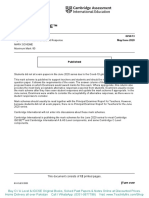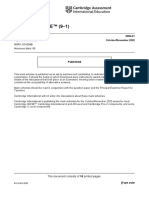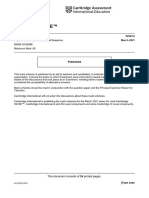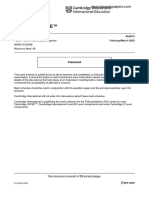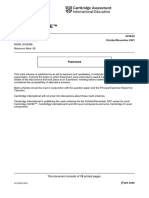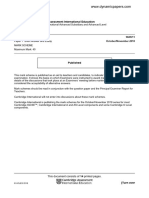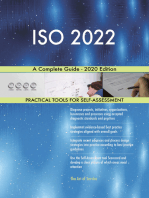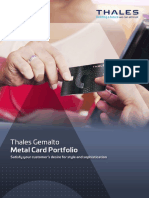Cambridge IGCSE™: Business Studies 0450/13 October/November 2020
Cambridge IGCSE™: Business Studies 0450/13 October/November 2020
Uploaded by
ESHMEET KAUR MALHOTRACopyright:
Available Formats
Cambridge IGCSE™: Business Studies 0450/13 October/November 2020
Cambridge IGCSE™: Business Studies 0450/13 October/November 2020
Uploaded by
ESHMEET KAUR MALHOTRAOriginal Title
Copyright
Available Formats
Share this document
Did you find this document useful?
Is this content inappropriate?
Copyright:
Available Formats
Cambridge IGCSE™: Business Studies 0450/13 October/November 2020
Cambridge IGCSE™: Business Studies 0450/13 October/November 2020
Uploaded by
ESHMEET KAUR MALHOTRACopyright:
Available Formats
Cambridge IGCSE™
BUSINESS STUDIES 0450/13
Paper 1 Short Answer/Structured Response October/November 2020
MARK SCHEME
Maximum Mark: 80
Published
This mark scheme is published as an aid to teachers and candidates, to indicate the requirements of the
examination. It shows the basis on which Examiners were instructed to award marks. It does not indicate the
details of the discussions that took place at an Examiners’ meeting before marking began, which would have
considered the acceptability of alternative answers.
Mark schemes should be read in conjunction with the question paper and the Principal Examiner Report for
Teachers.
Cambridge International will not enter into discussions about these mark schemes.
Cambridge International is publishing the mark schemes for the October/November 2020 series for most
Cambridge IGCSE™, Cambridge International A and AS Level and Cambridge Pre-U components, and some
Cambridge O Level components.
This document consists of 20 printed pages.
© UCLES 2020 [Turn over
0450/13 Cambridge IGCSE – Mark Scheme October/November 2020
PUBLISHED
Generic Marking Principles
These general marking principles must be applied by all examiners when marking candidate answers. They should be applied alongside the
specific content of the mark scheme or generic level descriptors for a question. Each question paper and mark scheme will also comply with these
marking principles.
GENERIC MARKING PRINCIPLE 1:
Marks must be awarded in line with:
• the specific content of the mark scheme or the generic level descriptors for the question
• the specific skills defined in the mark scheme or in the generic level descriptors for the question
• the standard of response required by a candidate as exemplified by the standardisation scripts.
GENERIC MARKING PRINCIPLE 2:
Marks awarded are always whole marks (not half marks, or other fractions).
GENERIC MARKING PRINCIPLE 3:
Marks must be awarded positively:
• marks are awarded for correct/valid answers, as defined in the mark scheme. However, credit is given for valid answers which go beyond the
scope of the syllabus and mark scheme, referring to your Team Leader as appropriate
• marks are awarded when candidates clearly demonstrate what they know and can do
• marks are not deducted for errors
• marks are not deducted for omissions
• answers should only be judged on the quality of spelling, punctuation and grammar when these features are specifically assessed by the
question as indicated by the mark scheme. The meaning, however, should be unambiguous.
GENERIC MARKING PRINCIPLE 4:
Rules must be applied consistently, e.g. in situations where candidates have not followed instructions or in the application of generic level
descriptors.
© UCLES 2020 Page 2 of 20
0450/13 Cambridge IGCSE – Mark Scheme October/November 2020
PUBLISHED
GENERIC MARKING PRINCIPLE 5:
Marks should be awarded using the full range of marks defined in the mark scheme for the question (however; the use of the full mark range may
be limited according to the quality of the candidate responses seen).
GENERIC MARKING PRINCIPLE 6:
Marks awarded are based solely on the requirements as defined in the mark scheme. Marks should not be awarded with grade thresholds or
grade descriptors in mind.
© UCLES 2020 Page 3 of 20
0450/13 Cambridge IGCSE – Mark Scheme October/November 2020
PUBLISHED
Question Answer Marks Notes
1(a) Define ‘entrepreneur’. 2 Do not award answers such as managing a
business or identifies skills of an entrepreneur on
Award 2 marks for a full definition. Award 1 mark for a partial its own as this does not define the term.
definition.
For both marks, need idea of starting a business
A person who organises, operates and takes the risk for a new and takes (financial) risks to do so.
business venture [2]
An individual who takes the financial risk of starting and managing a
new business [2]
Partial definition e.g. a person who starts/sets up a business [1]
1(b) State two reasons why sampling is used when carrying out 2 Only award the first two responses given.
market research.
Award 1 mark per reason.
Points might include:
• To bring the population to a manageable number/reduce number
of people asked
• To reduce cost (of having to ask large numbers of people)
• To save time (to carry out market research)
• To help reduce errors caused by having a large number in the
population
Other appropriate responses should also be credited.
© UCLES 2020 Page 4 of 20
0450/13 Cambridge IGCSE – Mark Scheme October/November 2020
PUBLISHED
Question Answer Marks Notes
1(c) Outline two ways in which being ethical could help Mercy and 4 Note: To use words from the stem as application,
Ayo’s business. the reference must be appropriate (i.e. make
sense) in relation to the point being made.
Award 1 mark for each relevant way.
The following words are likely to be appropriate for
Award 1 mark for each relevant reference to this business. this question:
Points might include: • Ice cream
• Higher revenue/increase demand/enter new market [k] for ice • Shop/store
cream [app] • Organic/milk/farm
• Improved brand image/reputation [k] for the shop [app] • Entrepreneur
• Build/encourage customer loyalty [k] for this new business [app] • New business/start-up
• Help create good supplier relations [k] so able to obtain high-
quality milk [app] Other appropriate examples in context can still be
• Investors more likely to invest [k] credited.
• Improve employee motivation/help recruit employees [k]
• May be possible to set a premium price/increase price [k] Do not award ‘better quality’, ‘legal’ or ‘rights’ as
• Less opposition from pressure groups [k] these are different concepts.
Other appropriate responses should also be credited. Do not accept answers which explain how a
business can be ethical as this is not the question.
© UCLES 2020 Page 5 of 20
0450/13 Cambridge IGCSE – Mark Scheme October/November 2020
PUBLISHED
Question Answer Marks Notes
1(d) Explain two ways in which market research results can help 6 Note: To use words from the stem as application,
Mercy and Ayo’s business. the reference must be appropriate (i.e. make
sense) in relation to the point being made.
Award 1 mark for identification of each relevant way (max 2).
The following words are likely to be appropriate for
Award 1 mark for each relevant reference made to this business this question:
(max 2). • Ice cream
• Shop/ store
Award 1 mark for each relevant explanation (max 2). • Organic milk/farm
• Entrepreneur
Points might include: • New business/start-up
• Identify consumer needs/demand/target market [k] as it’s a new • 300 (people)
business [app] to ensure sales/revenue [an]
• Helps set price/decide what price to set [k] to help ensure they Other appropriate examples in context can still be
can break-even/ cover costs [an] credited.
• Help decide how to promote/promotion strategy for its products [k]
• Help decide the best location/place/distribution channel [k] so
know whether/where to locate the shop [app]
• Help identify (strength of) the competition [k]
• Help decide what/amount to produce/buy right amount of raw
materials [k] to keep variable costs low/reduce wastage [an]
• Reduces risks/products launched with more confidence [k] for
these entrepreneurs [app]
• Discover current and future market size/trends [k] for ice cream
[app]
Other appropriate responses should also be credited.
© UCLES 2020 Page 6 of 20
0450/13 Cambridge IGCSE – Mark Scheme October/November 2020
PUBLISHED
1(e) Do you think a new business has a better chance of success if it 6 This is a general question so there are no marks
locates where there is no competition? Justify your answer. for application.
Award up to 2 marks for identification of relevant issues. Some points could be awarded for different
options, but do not award the same point twice.
Award up to 2 marks for relevant development of points.
For evaluation to be awarded justification will
Award 2 marks for justified decision as to whether a new business has usually follow on from relevant analysis of points.
a better chance of success if it locates where there is no competition.
Do not award vague answers such as ‘easier to
Points might include: compete, ‘lower/high risk’.
• Able to gain more customers/sales/no risk of brand loyalty to
another business [k] so increase in (potential) revenue/market Do not award answers which outline solutions
share [an] such as ‘should advertise’ etc.
• May indicate a gap in the market [k]
• Lower costs of promotion [k] reduce expenses/can help maintain/
improve its profit margin. [an]
• May indicate low demand/few or no customers available/small
target market [k] so difficult to break-even [an]
• Could depend on product or service offered [k] as if they have
developed a new product there may not be many competitors [an]
• Able to set higher prices (as no one to compete against) [k]
leading to higher revenue [an]
Justification might include:
I think they have less chance of success. While setting up where there
are no customers may allow them to gain more customers [k] which
can increase revenue [an]. But it might also mean there are few or no
customers available [k] so small target market [an]. However, if there
is no demand, there is no point in setting up there unless it is unique
because they will not gain enough sales to break even let alone be
successful. [eval] [eval]
Other appropriate responses should also be credited.
© UCLES 2020 Page 7 of 20
0450/13 Cambridge IGCSE – Mark Scheme October/November 2020
PUBLISHED
Question Answer Marks Notes
2(a) Define ‘job production’. 2
Award 2 marks for a full definition. Award 1 mark for a partial
definition.
Where a single product is made at a time [2]
Makes one product from start to finish (before starting the next one)
[2]
Produce a (personalised) product individually [2]
Partial definition e.g. single product made [1]
Produce a personalised product [1]
2(b) Identify two reasons why a business might want to expand. 2 Only award the first two responses given.
Award 1 mark per reason.
Points might include:
• Increase sales/sales revenue
• Increase profit
• Return to shareholders
• Spread risk
• Increase reputation/brand image/prestige
• Increase customer base/target new markets
• Increase market share
• Economies of scale
Other appropriate responses should also be credited.
© UCLES 2020 Page 8 of 20
0450/13 Cambridge IGCSE – Mark Scheme October/November 2020
PUBLISHED
Question Answer Marks Notes
2(c) Outline two ways Lola and Raul’s business could use a website. 4 Note: To use words from the stem as application,
the reference must be appropriate (i.e. make
Award 1 mark for each relevant way. sense) in relation to the point being made.
Award 1 mark for each relevant reference to this business. The following words are likely to be appropriate for
this question:
Points might include: • Hand-printed or examples such as T-shirts/
• Take orders/sell its products [k] as well as the shop [app] bags/posters
• Advertise/promote/raise awareness/give out information about its • Tourists
products [k] to people other than tourists [app] • (Small) shop/store
• Obtain feedback/reviews [k] about its t-shirts [app]
• Advertise job vacancies [k] Other appropriate examples in context can still be
credited.
Other appropriate responses should also be credited.
© UCLES 2020 Page 9 of 20
0450/13 Cambridge IGCSE – Mark Scheme October/November 2020
PUBLISHED
Question Answer Marks Notes
2(d) Explain one advantage and one disadvantage to Lola and Raul of 6 Note: To use words from the stem as application,
being in a business partnership. the reference must be appropriate (i.e. make
sense) in relation to the point being made.
Award 1 mark for identification of each relevant advantage and
disadvantage (max 1 for each). The following words are likely to be appropriate for
this question:
Award 1 mark for each relevant reference made to this business • Hand-printed (items) or examples such as T-
(max 2). shirts/bags/posters
• Tourists
Award 1 mark for each relevant explanation (max 2). • Shop/ store
• Website
Points might include: • Introduce machinery
Advantage: Other appropriate examples in context can still be
• More ideas [k] about what type of hand printed items to offer [app] credited.
can help increase revenue/sales [an]
• Access to more capital (than sole trader) [k] to pay for setting up a
website [app] improving chance of expanding [an]
• More skills/expertise/can specialise [k] Raul does the finance and
sales [app] allowing time for Lola to focus on her job [an]
• Share loss/risk [k] so do not have to carry all the financial burden
[an]
• Share workload [k]
Disadvantage:
• Disagreements [k] such as how to increase output [app] which
could lead to lower productivity [an]
• Unlimited liability/each responsible for debts of other [k] so their
personal belongings are at risk as well [an] as the shop [app]
• Have to share profits [k]
• Slower decision-making [k]
Other appropriate responses should also be credited.
© UCLES 2020 Page 10 of 20
0450/13 Cambridge IGCSE – Mark Scheme October/November 2020
PUBLISHED
Question Answer Marks Notes
2(e) Do you think introducing machinery is a better way for a small 6 This is a general question so there are no marks
business to increase output than recruiting more employees? for application.
Justify your answer.
Advantages of one method can be presented as
Awards up to 2 marks for identification of relevant issues. disadvantages of the other method but do not
award the same point twice as mirror answers are
Award up to 2 marks for relevant development of points. not accepted.
Award 2 marks for justified decision as to whether introducing Candidates can also discuss factors which need to
machinery is a better way for a small business to increase output than be considered when making decisions about
recruiting more employees. increasing output e.g. cost, whether demand is
temporary or not.
Points might include:
For evaluation to be awarded justification will
Introducing machinery usually follow on from relevant analysis of points.
• Likely to be more consistent/better quality/fewer mistakes [k]
reducing the amount of rework/wastage [an] For evaluation, candidates must relate answer to
• Machines do not need to rest [k] so can work for longer periods of increase in output.
time/24-7 [an]
• Higher productivity/more efficient [k] lower average cost [an]
• High cost/expensive to invest in equipment [k] which would
increase cash outflows [an] which a small business might not be
able to afford [an]
• May not have space to introduce machinery [k]
• May required more skilled workers [k] increasing labour costs [an]
• Higher maintenance costs [k] increasing expenses [an]
• Can become outdated quite quickly/need to replace regularly [k]
Recruit some/additional employees:
• Cost/time to recruit [k]
• Training may be required [k] increase costs [an]
Other appropriate responses should also be credited.
© UCLES 2020 Page 11 of 20
0450/13 Cambridge IGCSE – Mark Scheme October/November 2020
PUBLISHED
Question Answer Marks Notes
2(e) Justification might include:
Using machinery is likely to mean fewer mistakes [k] reducing the
amount of rework [an]. Whereas having more employees could mean
training is required [k] which increases costs [an]. However, it may still
be better for a small business to recruit more employees, especially if
the increase in output is only temporary as the initial cost of machinery
is likely to high. Therefore, it might be safer for a small business to
wait before taking a major financial decision to see whether the higher
level of demand can be sustained. [eval] [eval]
Question Answer Marks Notes
3(a) Define ‘non-current assets’. 2 Do not award examples.
Award 2 marks for a full definition. Award 1 mark for a partial
definition.
Resources owned by a business which will be used for a period longer
than one year [2]
Items owned by a business that last for more than 12 months [2]
Partial definition e.g. items owned by a business
© UCLES 2020 Page 12 of 20
0450/13 Cambridge IGCSE – Mark Scheme October/November 2020
PUBLISHED
Question Answer Marks Notes
3(b) Calculate the acid test ratio. Show your working. 2
Award 2 marks for correct calculation.
Correct answer 0.67 or 0.66 [2]
Method e.g. current assets – inventory/current liabilities
OR 60 – 40 / 30 [1]
If correct answer given with no working shown, award 2 marks.
3(c) State four factors that can affect the source of finance a business 4 Only award the first four responses given.
might use.
Award 1 mark per factor.
Points might include:
• Amount needed
• Existing borrowing gearing
• Length of time/how long to repay
• Purpose/what it is needed for
• Level of security/assets available to use as guarantee
• Interest rates
• Legal form/type of business/size of business
• Loss of ownership/control
Other appropriate responses should also be credited.
© UCLES 2020 Page 13 of 20
0450/13 Cambridge IGCSE – Mark Scheme October/November 2020
PUBLISHED
Question Answer Marks Notes
3(d) Explain two ways in which local communities might be affected 6 Note: Ways can be either positive or negative.
by CLN’s decision to close some of its shops.
Note: To use words from the stem as application,
Award 1 mark for identification of each relevant way (max 2). the reference must be appropriate (i.e. make
sense) in relation to the point being made.
Award 1 mark for each relevant reference made to this business
(max 2). The following words are likely to be appropriate for
this question:
Award 1 mark for each relevant explanation (max 2). • 30 or 120 (shops)
• Electrical products or examples such as
Points might include: televisions / computers
• Job losses/higher unemployment [k] so lower standard of • $250m (loss)
living/have less money to spend at other businesses [an] as well
as those selling electrical goods [app] Other appropriate examples in context can still be
• Environmental benefits or examples such as less traffic [k] so less credited.
pollution (leading to health issues) [an] outside the 120 shops
[app]
• Reduction in local facilities [k] which could lead to higher prices
having to be paid [an]
• Reduction in house prices/damage image of the local area [k]
Other appropriate responses should also be credited.
© UCLES 2020 Page 14 of 20
0450/13 Cambridge IGCSE – Mark Scheme October/November 2020
PUBLISHED
Question Answer Marks Notes
3(e) Do you think the number of sales from each shop is the best way 6 This is a general question so there are no marks
for a retail business to decide which shops to close? Justify your for application.
answer.
Some points could be awarded for different
Award up to 2 marks for identification of relevant issues. options, but do not award the same point twice.
Award up to 2 marks for relevant development of points. For evaluation to be awarded justification will
usually follow on from relevant analysis of points.
Award 2 marks for justified decision as to whether the number of sales
from each shop is the best way for a retail business to decide which
shops to close.
Points might include:
• Higher sales could mean higher revenue [k] which can help
contribute to break-even [an]
• Lower sales could suggest shop is not a popular location [k] so
customers less likely to complain if it closes [an]
• What products are sold [k] as a shop selling high value items
would not need to sell many as one selling low value items [an]
Other factors could include:
• Costs/expenses [k] as a business could be still be profitable as
long as costs are lower than revenue [an]
• Number of competitors [k] as a shop with many competitors might
have a lower market share leading to fewer potential sales [an]
• Size of target market/number of customers [k]
• Profit [k]
• Number of employees [k]
• Value of sales/revenue [k]
• Proximity to its other shops [k]
Other appropriate responses should also be credited.
© UCLES 2020 Page 15 of 20
0450/13 Cambridge IGCSE – Mark Scheme October/November 2020
PUBLISHED
Question Answer Marks Notes
3(e) Justification might include:
Lower sales could suggest shop is not popular [k] so customers less
likely to complain if it closes [an]. However, lower sales might be
misleading as some shops might sell a small number of higher value
items [k] so number of sales alone might lead to a potential loss of
revenue [an]. Costs could be used as a factor, but the problem is that
a popular location might have a higher rent. Therefore, as no method
will give perfect answers but as number of sales is probably best
especially as it is simple to use, so at least people will be able to
understand the reasons for using it. [eval][eval]
Question Answer Marks Notes
4(a) State two ways quality production can be achieved. 2 Only award the first two responses given.
Award 1 mark per way. Do not award lean production as this is a different
concept.
Points might include:
• Quality control Do not award vague answers such as use
• Quality assurance machinery/improve motivation/check quality
• Total Quality Management/quality circles
• Further training/recruit skilled workers
• Improve quality of raw materials
• Use new/better technology/CAM/CAD
Other appropriate responses should also be credited.
© UCLES 2020 Page 16 of 20
0450/13 Cambridge IGCSE – Mark Scheme October/November 2020
PUBLISHED
Question Answer Marks Notes
4(b) Identify two benefits to a business of having a clear 2 Only award the first two responses given.
organisational structure.
Award one mark per benefit.
Points might include:
• Shows how everybody is linked together in the organisation
• Each individual can see their own position in the organisation/
makes accountability easier
• It shows the links and relationship between different departments
• Can show where possible problems of control/communication
might be/helps clear communication
• Allows for effective delegation
Other appropriate responses should also be credited.
4(c) Outline two factors Kane should consider when preparing the job 4 Note: To use words from the stem as application,
advertisement. the reference must be appropriate (i.e. make
sense) in relation to the point being made.
Award 1 mark for each relevant factor.
The following words are likely to be appropriate for
Award 1 mark for each relevant reference to this business. this question:
• Furniture/wood
Points might include: • 5 (production workers)
• What information to include [k] such as skills needed to make • Well-motivated employees
furniture [app]
• Where advert should be placed/which method of job Other appropriate examples in context can still be
advertisement to use [k] for 5 production workers [app] credited.
• Cost/which method can they afford to use [k]
• Comply with legal controls i.e. no age/gender discrimination [k]
Other appropriate responses should also be credited.
© UCLES 2020 Page 17 of 20
0450/13 Cambridge IGCSE – Mark Scheme October/November 2020
PUBLISHED
Question Answer Marks Notes
4(d) Explain how each of the following external influences might 6 Note: To use words from the stem as application,
affect LFP: the reference must be appropriate (i.e. make
sense) in relation to the point being made.
Award 1 mark for each relevant affect (max 1 for each influence).
The following words are likely to be appropriate for
Award 1 mark for each relevant reference made to this business this question:
(max 2). • Furniture
• wood
Award 1 mark for each relevant explanation (max 2). • 5 (production workers)
• 40%
Points might include:
Other appropriate examples in context can still be
Lower employment levels: credited.
• Wider pool of potential employees [k] for the 5 workers [app]
possibly at lower wage rates/better able to find quality candidates
[an]
• Lower incomes [k] lower demand/lower sales [an] for its furniture
[app]
Import quotas:
• Limit amount of products that a business can bring into a country
[k] so have access to less wood [app] so may be unable to fulfil all
its orders [an]
• Could force LFP to find new suppliers [k] as 40% imported [app]
which could increase costs of sales/selling price [an]
Other appropriate responses should also be credited.
© UCLES 2020 Page 18 of 20
0450/13 Cambridge IGCSE – Mark Scheme October/November 2020
PUBLISHED
Question Answer Marks Notes
4(e) Do you think increasing wages is a better way for a business to 6 This is a general question so there are no marks
motivate employees than introducing profit sharing? Justify your for application.
answer.
Some points could be awarded for different
Award up to 2 marks for identification of relevant issues. options, but do not award the same point twice.
Award up to 2 marks for relevant development of points. For evaluation to be awarded justification will
usually follow on from relevant analysis of points.
Award 2 marks for justified decision as to whether increasing wages in
a better way for a business to motivate employees than introducing
profit sharing.
Points might include:
Increase wages:
• Taylor’s theory suggests that higher wages increases motivation/
Herzberg’s theory states pay is a hygiene factor and not a
motivator [k]
• Higher wages add to business costs [k] which may not be covered
by the additional output [an]
• Only a short-term boost to motivation/likely to be paid the higher
amount whether they work harder or not [k] so any increase is
productivity is only temporary [an]
• Will provide a regular/steady income [k] to maintain standard of
living [an]
Profit sharing:
• Creates team spirit/common goal/sense of belonging/all
employees focused on success of business [k] which could lead
to higher overall profit/increase output [an]
• Only receive/pay out if profits made [k]
• Sharing profits might reduce retained profit [k] which could mean
less capital for expansion [an]
© UCLES 2020 Page 19 of 20
0450/13 Cambridge IGCSE – Mark Scheme October/November 2020
PUBLISHED
Question Answer Marks Notes
4(e) • Other factors can affect profit which employees cannot control [k]
so there is no guarantee they will receive any/much from profit
sharing [an]
Other appropriate responses should also be credited.
Justification might include:
Higher wages add to business costs [k] which might increase more
than output increases [an]. Whereas sharing profits might reduce
retained profit [k] which could mean less capital for expansion [an]
However, I think profit sharing is the better way. This is because
higher wages will automatically have to be paid whether business
makes a profit or not which could also reduce the potential profit that a
business can make so it is better to use profit sharing as the business
only has to give it when a profit has been made. [eval] [eval]
© UCLES 2020 Page 20 of 20
You might also like
- "H. J. Heinz M&A": Case StudyDocument8 pages"H. J. Heinz M&A": Case StudySudhanva S 1510214100% (10)
- Acko PolicyDocument6 pagesAcko PolicyEswar VakkalagaddaNo ratings yet
- Cambridge O Level: Business Studies 7115/11 October/November 2020Document20 pagesCambridge O Level: Business Studies 7115/11 October/November 2020r3za_5008No ratings yet
- LIFO, FIFO, Simple Avg, Weighted Avg Questions PDFDocument7 pagesLIFO, FIFO, Simple Avg, Weighted Avg Questions PDFVishesh GuptaNo ratings yet
- Cambridge IGCSE™: Business Studies 0450/13 October/November 2020Document20 pagesCambridge IGCSE™: Business Studies 0450/13 October/November 2020Wilfred BryanNo ratings yet
- Cambridge IGCSE™: Business Studies 0450/12 October/November 2020Document21 pagesCambridge IGCSE™: Business Studies 0450/12 October/November 2020سعدیNo ratings yet
- Cambridge IGCSE™: Business Studies 0450/11 October/November 2020Document20 pagesCambridge IGCSE™: Business Studies 0450/11 October/November 2020Year 9No ratings yet
- Cambridge IGCSE™: Business Studies 0450/11 May/June 2020Document10 pagesCambridge IGCSE™: Business Studies 0450/11 May/June 2020Daniel NAMNo ratings yet
- Cambridge O Level: Business Studies 7115/12 October/November 2020Document21 pagesCambridge O Level: Business Studies 7115/12 October/November 2020r3za_5008No ratings yet
- Cambridge IGCSE™: Business Studies 0450/12 October/November 2020Document21 pagesCambridge IGCSE™: Business Studies 0450/12 October/November 2020Bhone TheinKhaKyawNo ratings yet
- Cambridge O Level: Business Studies 7115/11 May/June 2020Document11 pagesCambridge O Level: Business Studies 7115/11 May/June 2020Fred SaneNo ratings yet
- Cambridge O Level: Business Studies 7115/12 May/June 2020Document12 pagesCambridge O Level: Business Studies 7115/12 May/June 2020Fred SaneNo ratings yet
- Cambridge International AS & A Level: Business 9609/12 October/November 2020Document15 pagesCambridge International AS & A Level: Business 9609/12 October/November 2020Jawad NadeemNo ratings yet
- Cambridge Assessment International Education: Business 9609/11 October/November 2018Document14 pagesCambridge Assessment International Education: Business 9609/11 October/November 2018Low JeNo ratings yet
- 0450 s20 Ms 13 PDFDocument12 pages0450 s20 Ms 13 PDFShimaa Abdel azizNo ratings yet
- 9609 s19 Ms 12Document12 pages9609 s19 Ms 12Hashir Naveed MirzaNo ratings yet
- Cambridge IGCSE™ (9-1) : Business Studies 0986/12 May/June 2020Document11 pagesCambridge IGCSE™ (9-1) : Business Studies 0986/12 May/June 2020Viral TiktoksNo ratings yet
- Cambridge Assessment International Education: Business 9609/11 October/November 2019Document15 pagesCambridge Assessment International Education: Business 9609/11 October/November 2019skaugfdgvwafNo ratings yet
- Cambridge Assessment International Education: Business Studies 0450/23 May/June 2018Document13 pagesCambridge Assessment International Education: Business Studies 0450/23 May/June 2018Ayesha JagotNo ratings yet
- Mark Schdeme - 13Document15 pagesMark Schdeme - 13bmensahgms2No ratings yet
- Cambridge IGCSE™: Business Studies 0450/22 May/June 2020Document14 pagesCambridge IGCSE™: Business Studies 0450/22 May/June 2020Wilfred BryanNo ratings yet
- Cambridge International AS & A Level: Business 9609/22 October/November 2022Document24 pagesCambridge International AS & A Level: Business 9609/22 October/November 2022aromajaryanNo ratings yet
- Cambridge Assessment International Education: Business 9609/13 May/June 2019Document12 pagesCambridge Assessment International Education: Business 9609/13 May/June 2019AbdulBasitBilalSheikhNo ratings yet
- Cambridge O Level: Business Studies 7115/22 May/June 2020Document14 pagesCambridge O Level: Business Studies 7115/22 May/June 2020uwu xdNo ratings yet
- November 2020 Mark Scheme Paper 21Document16 pagesNovember 2020 Mark Scheme Paper 21Edwin OdwesoNo ratings yet
- Cambridge International AS & A Level: Business 9609/22 March 2021Document16 pagesCambridge International AS & A Level: Business 9609/22 March 2021LisaNo ratings yet
- Cambridge O Level: Business Studies 7115/22 October/November 2020Document15 pagesCambridge O Level: Business Studies 7115/22 October/November 2020r3za_5008No ratings yet
- Cambridge International AS & A Level: Business 9609/11 May/June 2020Document14 pagesCambridge International AS & A Level: Business 9609/11 May/June 2020VinayakNo ratings yet
- Cambridge International AS & A Level: Business 9609/11 May/June 2020Document14 pagesCambridge International AS & A Level: Business 9609/11 May/June 2020tekatekapaseka1No ratings yet
- Cambridge Assessment International Education: Business 9609/12 October/November 2018Document14 pagesCambridge Assessment International Education: Business 9609/12 October/November 2018Low JeNo ratings yet
- Cambridge O Level: Business Studies 7115/24 May/June 2021Document19 pagesCambridge O Level: Business Studies 7115/24 May/June 2021nayna sharminNo ratings yet
- Cambridge Assessment International Education: Business Studies 0450/11 October/November 2019Document20 pagesCambridge Assessment International Education: Business Studies 0450/11 October/November 2019Punn PosayapisithNo ratings yet
- Cambridge Assessment International Education: Business Studies 0450/13 May/June 2018Document16 pagesCambridge Assessment International Education: Business Studies 0450/13 May/June 2018Ayesha JagotNo ratings yet
- Cambridge O Level: Business Studies 7115/21 October/November 2020Document16 pagesCambridge O Level: Business Studies 7115/21 October/November 2020r3za_5008No ratings yet
- Cambridge IGCSE™: Business Studies 0450/22 May/June 2021Document17 pagesCambridge IGCSE™: Business Studies 0450/22 May/June 2021kev officielNo ratings yet
- Cambridge IGCSE™: Business Studies 0450/22 March 2020Document15 pagesCambridge IGCSE™: Business Studies 0450/22 March 2020Aryan AgarwalNo ratings yet
- Part 3Document18 pagesPart 3நாஞ்சில் அருள்No ratings yet
- Cambridge International AS & A Level: EconomicsDocument15 pagesCambridge International AS & A Level: EconomicsAndrew BadgerNo ratings yet
- Cambridge International AS & A Level: Business 9609/22 May/June 2021Document22 pagesCambridge International AS & A Level: Business 9609/22 May/June 2021Daliya chaudhariNo ratings yet
- Answer For As Level Past PaperDocument14 pagesAnswer For As Level Past PaperReddy Girinath100% (1)
- 9609 MW ScriptAC P1 MSDocument14 pages9609 MW ScriptAC P1 MS章琳雯No ratings yet
- Cambridge Assessment International Education: Business Studies 0450/22 March 2018Document13 pagesCambridge Assessment International Education: Business Studies 0450/22 March 2018Ayesha JagotNo ratings yet
- Cambridge International AS & A Level: Business 9609/22 February/March 2022Document24 pagesCambridge International AS & A Level: Business 9609/22 February/March 2022thabo bhejaneNo ratings yet
- 2027 Specimen Paper 2 Mark SchemeDocument18 pages2027 Specimen Paper 2 Mark SchemeshujaitbukhariNo ratings yet
- Enterprise 2Document12 pagesEnterprise 2pilar.mohamed1237No ratings yet
- 9609 MW ScriptB P1 MSDocument12 pages9609 MW ScriptB P1 MS章琳雯No ratings yet
- Cambridge Assessment International Education: Business 9609/31 May/June 2019Document16 pagesCambridge Assessment International Education: Business 9609/31 May/June 2019Find tutorNo ratings yet
- IGCSE Past Paper Mark SchemeDocument17 pagesIGCSE Past Paper Mark SchemeSwra GhelaniNo ratings yet
- 9708 w22 Ms 41 PDFDocument16 pages9708 w22 Ms 41 PDFTawanda MakombeNo ratings yet
- Cambridge Assessment International Education: Enterprise 0454/11 October/November 2019Document12 pagesCambridge Assessment International Education: Enterprise 0454/11 October/November 2019Alexius BaghiNo ratings yet
- Cambridge International AS & A Level: Accounting 9706/31 October/November 2022Document17 pagesCambridge International AS & A Level: Accounting 9706/31 October/November 2022ryan valtrainNo ratings yet
- Cambridge IGCSE™: Business Studies 0450/12 March 2021Document24 pagesCambridge IGCSE™: Business Studies 0450/12 March 2021Kausika ThanarajNo ratings yet
- Cambridge IGCSE™: Business Studies 0450/11 October/November 2021Document22 pagesCambridge IGCSE™: Business Studies 0450/11 October/November 2021Callum BirdNo ratings yet
- s25Document22 pagess25ranat.2027No ratings yet
- Cambridge International AS & A Level: Business 9609/23 October/November 2020Document16 pagesCambridge International AS & A Level: Business 9609/23 October/November 2020Kwadwo AsareNo ratings yet
- Cambridge IGCSE™: Business Studies 0450/23 May/June 2020Document14 pagesCambridge IGCSE™: Business Studies 0450/23 May/June 2020Damien MambuduNo ratings yet
- Cambridge International AS & A Level: Economics 9708/42 February/March 2022Document16 pagesCambridge International AS & A Level: Economics 9708/42 February/March 2022thabo bhejaneNo ratings yet
- Cambridge IGCSE™: Business Studies 0450/22 October/November 2021Document19 pagesCambridge IGCSE™: Business Studies 0450/22 October/November 2021CjayyyNo ratings yet
- Cambridge Assessment International Education: Business 9609/11 October/November 2018Document14 pagesCambridge Assessment International Education: Business 9609/11 October/November 2018RuslanNo ratings yet
- Cambridge International AS & A Level: Economics 9708/22 February/March 2022Document12 pagesCambridge International AS & A Level: Economics 9708/22 February/March 2022Andrew BadgerNo ratings yet
- Cambridge IGCSE™: Travel and Tourism 0471/23 May/June 2022Document12 pagesCambridge IGCSE™: Travel and Tourism 0471/23 May/June 2022chayma melitiNo ratings yet
- Chapter 34: Population: Suggested Answers To Individual and Group ActivitiesDocument2 pagesChapter 34: Population: Suggested Answers To Individual and Group ActivitiesESHMEET KAUR MALHOTRANo ratings yet
- Mayor ArticleDocument2 pagesMayor ArticleESHMEET KAUR MALHOTRANo ratings yet
- Chapter 1: The Nature of The Economic Problem: Suggested Answers To Individual and Group ActivitiesDocument11 pagesChapter 1: The Nature of The Economic Problem: Suggested Answers To Individual and Group ActivitiesESHMEET KAUR MALHOTRA100% (2)
- Linear ProgrammingDocument2 pagesLinear ProgrammingESHMEET KAUR MALHOTRANo ratings yet
- EIC Materials: Name: Position: SchoolDocument40 pagesEIC Materials: Name: Position: SchoolAlona BaucaNo ratings yet
- Statement PT - Smoe IndonesiaDocument4 pagesStatement PT - Smoe IndonesiaflovtaNo ratings yet
- Day of Turmoil As Negative Rates Strike Fear Into Global MarketsDocument24 pagesDay of Turmoil As Negative Rates Strike Fear Into Global MarketsstefanoNo ratings yet
- Africa Grant Funding: Any African NationalDocument2 pagesAfrica Grant Funding: Any African NationalFampau CoulibalyNo ratings yet
- CCPS - BT C4-C5Document3 pagesCCPS - BT C4-C5Nguyễn Hải ThanhNo ratings yet
- Short-Notes-of-Corporate GovernanceDocument3 pagesShort-Notes-of-Corporate GovernancepriashNo ratings yet
- Aggregate Planning & Pricing at Mintendo (Toys R Us)Document2 pagesAggregate Planning & Pricing at Mintendo (Toys R Us)hina firdous0% (1)
- Mega Projects of BangladeshDocument76 pagesMega Projects of BangladeshNodiNo ratings yet
- Assignment On Market ResearchDocument17 pagesAssignment On Market Researchsaherhcc4686No ratings yet
- ERCC Guide To Best Practice March 2022Document140 pagesERCC Guide To Best Practice March 2022sunny.main.pennytradeNo ratings yet
- Accounting Workbook 2 - Answer KeyDocument57 pagesAccounting Workbook 2 - Answer KeyAbby VillagraciaNo ratings yet
- Microfintech: Expanding Financial Inclusion With Cost-Cutting InnovationDocument281 pagesMicrofintech: Expanding Financial Inclusion With Cost-Cutting InnovationAN100% (1)
- Overview of International Business FunctionsDocument54 pagesOverview of International Business Functionsapi-3727758100% (3)
- All LOs Establish Quality Standard PDFDocument20 pagesAll LOs Establish Quality Standard PDFHabteNo ratings yet
- Module 5.2 - Sample ExercisesDocument8 pagesModule 5.2 - Sample ExercisesJaimell LimNo ratings yet
- Assignment 3Document3 pagesAssignment 3atharvamalandkarNo ratings yet
- PlanningDocument60 pagesPlanningNavaia MinósNo ratings yet
- The Effects of Earnings Management and Audit Quality On Cost of Equity Capital - Empirical Evidence From IndonesiaDocument8 pagesThe Effects of Earnings Management and Audit Quality On Cost of Equity Capital - Empirical Evidence From IndonesiaRISKA DAMAYANTI AkuntansiNo ratings yet
- Fs Metal Card Portfolio - CleanedDocument6 pagesFs Metal Card Portfolio - CleanedjdloliveiraNo ratings yet
- 5 Benefits of Equality and Diversity in The WorkplaceDocument3 pages5 Benefits of Equality and Diversity in The WorkplaceMahmood KaderNo ratings yet
- Geographical Problems And: Its Suggested SolutionsDocument16 pagesGeographical Problems And: Its Suggested SolutionsDianne RubicoNo ratings yet
- On Income Tax Authorities 1-2Document5 pagesOn Income Tax Authorities 1-2MA AttariNo ratings yet
- AccountStatement 53886510Document1 pageAccountStatement 53886510anandnagarNo ratings yet
- CIR Vs Aluminum WheelsDocument3 pagesCIR Vs Aluminum WheelsJenifferRimandoNo ratings yet
- SSRN Id3478640Document37 pagesSSRN Id3478640Leonardo AmancioNo ratings yet
- Sources of Short-Term Project FinanceDocument2 pagesSources of Short-Term Project FinanceJogendra KumarNo ratings yet
- Modul English CorrespondenceDocument98 pagesModul English CorrespondenceKelvinNo ratings yet














